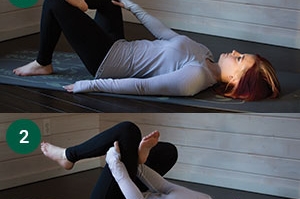
Fascial stretching can increase flexibility and decrease the chance of injury. Although it sounds like a complicated affair, fascial stretches are simple and can be incorporated into your daily routine to keep your muscles moving smoothly.
If you were playing a word association game and your partner prompted you with the word “fascia,” you might reply “roof” or “house.” But the kind of fascia we’re talking about is a group of tough fibrous tissues or membranes that surround, connect, and lend support to our muscles, bones, nerves, and blood vessels.
What is fascia?
We can think of fascia like the lining of a suitcase. The lining covers and connects the inner structure of the suitcase and forms distinct pockets. Likewise, our body has distinct organs, muscles, bones, et cetera, that are separate, yet covered and joined together by the continuous lining of our fascia.
Why is fascia important?
It increases strength and flexibility
Traditional static stretches isolate individual muscles, but fascial stretching engages an entire network of muscles, joints, tendons, ligaments, and bones. The result is increased flexibility, strength, and movement throughout a larger portion of the body.
It decreases injury
Conscious training of the fascial network is of great importance for athletes and fitness enthusiasts; underworked connective tissue is a common offender that can lead to injury. The human body offers a higher degree of injury prevention and performs more effectively before and after exercise, if our fascial connective tissue is optimally resilient and elastic.
Stretch it out
Chris Boyko is the strength and conditioning trainer for the BC Lions football club. He trained to become a certified fascial stretch therapist at the Stretch to Win Institute, and practises at 3 Peaks Health.
He says that the fascia of the hip area usually needs the most attention. Boyko emphasizes that the following stretches can be done anywhere, without any equipment. He enthusiastically recommends adding them to anyone’s workout routine.
Yoga and fascia
Yoga has traditionally been used to treat pain, both in muscle and its surrounding fascia; some common yoga poses place great emphasis on fascial stretching. In a 2014 study, eight physiotherapists who suffered from fascial pain experienced significant improvement after they completed a four-week hatha yoga program.
Moderate hip opener

Sit on the ground or floor with knees bent, feet flat and hip width apart. Place hands behind your hips, palm down, and fingers pointed away from you.
- Exhale, lean back, and slowly drop both knees to the left.
- Inhale, and return knees to centre.
- Exhale, and slowly drop both knees to the right.
- Inhale, and return knees to centre.
- Repeat stretch 10 times on each side.
Healthy hip flexors stretch

Begin in a lunge position with your right leg bent at 90 degrees, and your left leg back. Keep your abs pulled in, and your chest lifted high; inhale.
- Exhale and encourage the left hip to extend forward until you feel a slight stretch; hold for 10 seconds.
- Inhale slowly, then push further forward on the exhalation, with the intent to go a little deeper.
- Repeat until you feel the tissue release, then gently return back to a standing position.
- Repeat the stretch on the other side (left leg bent, right leg back).
Beginner hip stretch

- Begin on all fours, with hands positioned slightly wider than and under your shoulders, knees together, under your hips.
- Exhale and slowly drop your hips to the right.
- Inhale and slowly return hips back to centre.
- Exhale and slowly drop hips to the left.
- Inhale and slowly return hips back to centre.
- Repeat stretch 10 times on each side.
Deep gluteus maximus and rotators stretch

Begin by lying on your back, with feet flat on the floor and knees bent.
- Place right ankle on the left knee, using your hands to support your knee or ankle if needed.
- Inhale deeply, then exhale and gently push the right knee away from your body.
- Keeping the left leg at a 90 degree angle, exhale, wrap your fingers behind the left knee, and gently pull toward the centre of the chest.
- Pull until you feel the stretch, then hold for 10 seconds.
- Slowly return your left foot to the ground, then the right, and repeat the stretch on the other side.
Happy hamstring stretch

Lie on your back with knees bent, feet flat on the floor.
- Interlace fingers in front of the left knee, and slowly bring the knee to the chest.
- Keeping your head and shoulders on the floor, inhale deeply, then exhale as you gently straighten the left leg upward and then gently pull it toward the centre of chest.
- To increase the stretch, try to straighten the leg even more, and bring it closer to your chest with each exhalation.
- Slowly return to the starting position, and repeat the stretch using the right leg.
To find a certified fascial stretch therapist in your area, visit stretchtowin.com.
Fascial stretch therapy for fibromyalgia
People suffering from fibromyalgia experience long-term pain throughout the body. Through a system of assisted stretching, a fascial stretch therapist can help reduce pain and improve the quality of life for fibromyalgia patients.
Get rolling
Foam rollers typically cost between $10 and $40, a small investment for a big benefit. Foam rolling is beneficial for the fascia. It can
- stretch and loosen fascia
- improve flexibility
- relieve muscle soreness
- increase range of motion
Myo what?
Myofascia
This term refers to the fibrous tissue (fascia) that specifically surrounds and separates muscle tissue.
Myofascial release
This hands-on technique is used to apply gentle pressure to the myofascial connective tissue. The goal is to relieve pain and restore motion.




